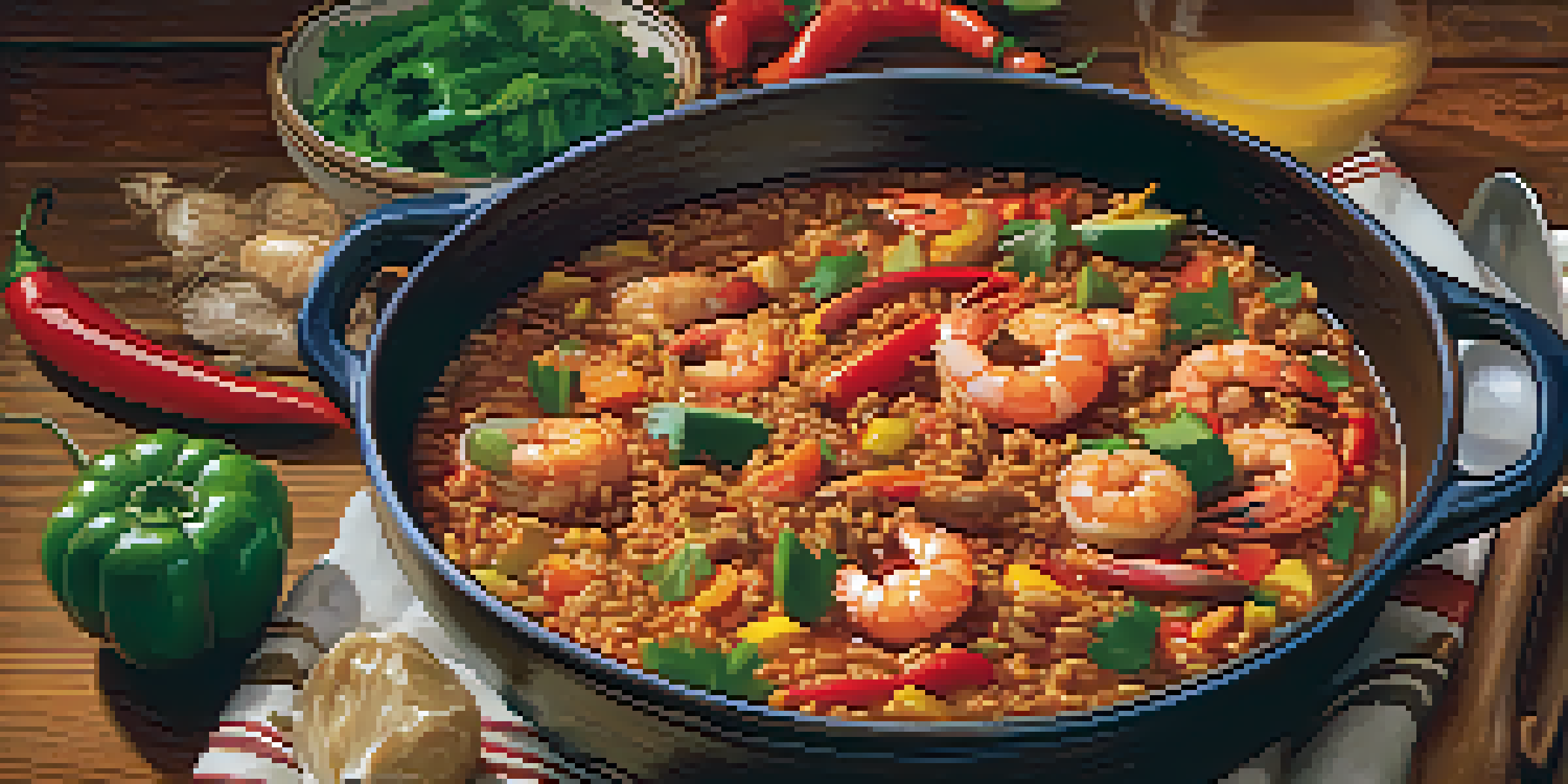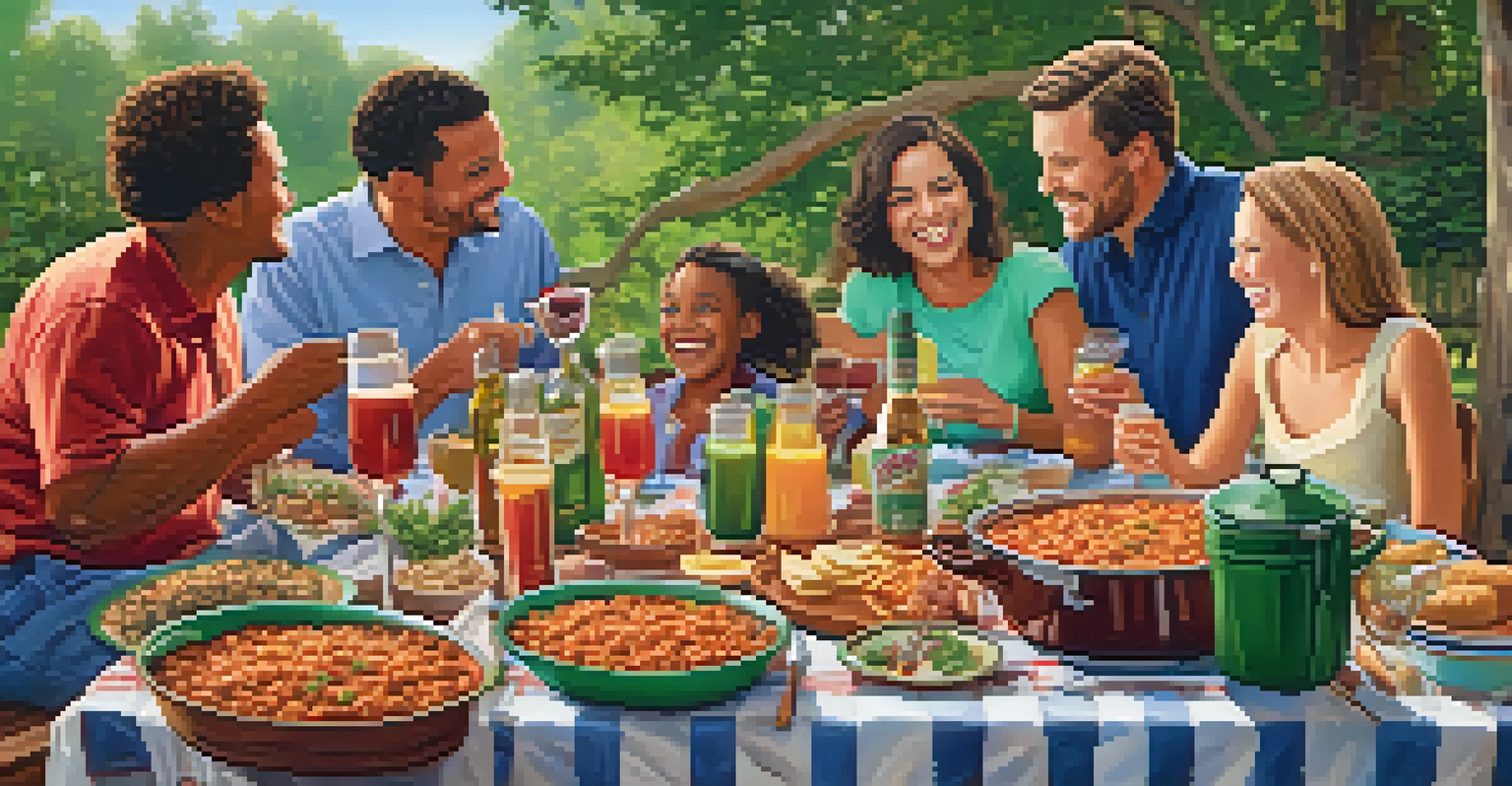Jambalaya: A Flavorful One-Pot Wonder from Louisiana

The Rich History Behind Jambalaya's Flavorful Origins
Jambalaya's roots trace back to the Spanish, French, and African influences in Louisiana. Originating in the early 18th century, it reflects the cultural melting pot that New Orleans is known for. Imagine the bustling markets and kitchens where spices and ingredients mingled, creating a dish that tells a story of its people.
Food is a central activity of mankind and one of the single most significant trademarks of a culture.
The dish was initially inspired by Spanish paella, adapted by local chefs who made it their own. Over time, jambalaya evolved, incorporating local seafood, meats, and vegetables. This adaptability mirrors the spirit of Louisiana itself, where food is more than just sustenance—it's a celebration of life.
From festive gatherings to family dinners, jambalaya has become synonymous with Southern hospitality. It’s often the centerpiece of celebrations, bringing people together to share not only a meal but also stories and laughter. Each pot of jambalaya is a testament to the rich traditions that continue to thrive today.
Key Ingredients: What Makes Jambalaya So Delicious?
At its core, jambalaya is a one-pot dish that combines rice, meat, and vegetables, but the magic lies in its ingredients. The foundation typically includes a blend of onions, bell peppers, and celery, known as the 'holy trinity' of Cajun cooking. This aromatic trio creates a savory base that enhances every bite.

Proteins vary widely, with options like chicken, sausage, shrimp, or even crawfish. Each ingredient contributes its unique flavor, allowing for endless variations to suit different tastes. Think of it like a canvas—chefs can paint their culinary masterpiece with whatever fresh ingredients are available.
Jambalaya's Cultural Roots
Jambalaya's origins reflect the diverse Spanish, French, and African influences in Louisiana, making it a true representation of New Orleans' cultural melting pot.
The spices are equally vital, with paprika, cayenne pepper, and thyme adding depth and warmth. It’s this combination of flavors that makes jambalaya not just a dish, but an experience. Each mouthful transports you to the heart of Louisiana, where every bite bursts with personality.
Jambalaya vs. Other Southern Dishes: What's the Difference?
While jambalaya shares similarities with dishes like gumbo and étouffée, it stands out in its preparation and presentation. Gumbo is typically served over rice and has a thinner, stew-like consistency, while jambalaya cooks everything together in one pot. This difference makes jambalaya more of a hearty meal, perfect for feeding a crowd.
The best way to experience a culture is through its food.
Another distinction lies in the use of rice: in jambalaya, the rice absorbs the flavors of the meat and spices during cooking. In contrast, gumbo emphasizes a rich broth with ingredients floating throughout. This one-pot wonder is often described as a 'party on a plate,' making it a go-to dish for gatherings.
Ultimately, while all these dishes celebrate Louisiana's culinary heritage, jambalaya's unique preparation and communal nature set it apart. Each variation has its charm, but jambalaya's ability to bring people together makes it a cherished favorite among locals and visitors alike.
How to Make Authentic Jambalaya at Home
Creating your own jambalaya at home is easier than you might think! Start by sautéing the 'holy trinity' of onions, bell peppers, and celery in a large pot. Once they’re golden and fragrant, add your choice of meat—whether it’s chicken, sausage, or shrimp—allowing the flavors to meld beautifully.
Next, stir in tomatoes, rice, and broth, then season generously with spices. The key is to let the rice absorb all those wonderful flavors, so be patient and let it simmer. As the dish cooks, your kitchen will fill with mouthwatering aromas, making it hard to resist sneaking a taste!
Key Ingredients Create Flavor
The iconic 'holy trinity' of onions, bell peppers, and celery, along with various proteins and spices, are essential for crafting the rich and complex flavors of jambalaya.
Once the rice is cooked and fluffy, remove the pot from the heat and let it rest for a few minutes. This step is crucial, as it allows the flavors to deepen. Serve your jambalaya with a sprinkle of fresh parsley or green onions, and enjoy a taste of Louisiana right at your dinner table!
Vegetarian and Vegan Jambalaya: A Twist on Tradition
If you're looking to enjoy jambalaya without meat, don’t worry! A vegetarian or vegan version can be just as flavorful and satisfying. Replace meat with hearty vegetables like zucchini, mushrooms, and bell peppers, along with beans or lentils for protein and texture.
Using vegetable broth instead of chicken or seafood broth enhances the dish while keeping it light and fresh. The same spices and seasonings apply, ensuring that every bite is packed with flavor. It’s a delightful way to experience the essence of jambalaya while accommodating different dietary preferences.
Many people are surprised at how easily they can adapt this classic recipe. With just a few simple swaps, you can create a vibrant, plant-based jambalaya that still captures the spirit of Louisiana. It’s proof that great food can be inclusive and delicious for everyone!
Jambalaya: Perfect for Any Occasion
One of the best things about jambalaya is its versatility for any occasion. Whether it’s a casual weeknight dinner, a festive family gathering, or a lively backyard barbecue, jambalaya fits right in. It’s a one-pot meal that requires minimal cleanup, allowing you to spend more time enjoying the company of friends and family.
During Mardi Gras or other celebrations, jambalaya often takes center stage, embodying the spirit of festivity. It’s not just food; it’s a symbol of togetherness, love, and the joy of sharing a meal. Imagine the vibrant colors, lively music, and laughter surrounding a big pot of jambalaya!
Versatile for Any Occasion
Jambalaya is a one-pot meal perfect for any gathering, easily scalable for intimate dinners or large celebrations, and embodies the spirit of togetherness.
Moreover, jambalaya is easy to scale up or down, making it perfect for both intimate dinners and large gatherings. You can whip up a small batch for two or a massive pot to feed a crowd. Regardless of the setting, it’s sure to be a hit, leaving everyone asking for seconds.
Where to Find the Best Jambalaya in Louisiana
If you're craving authentic jambalaya, Louisiana is the place to be! From bustling New Orleans to quaint small towns, you’ll find countless eateries serving their unique takes on this beloved dish. Local restaurants often pride themselves on their family recipes, passed down through generations, giving you a taste of true Southern hospitality.
Food festivals, like the annual New Orleans Jazz & Heritage Festival, showcase the region's culinary talents, offering jambalaya from various vendors. Here, you can sample different flavors and styles, making it a culinary adventure worth experiencing. Just imagine the delightful aromas and vibrant atmosphere!

For a more personalized touch, consider visiting local markets or food trucks. These hidden gems often serve some of the best jambalaya, made with fresh, local ingredients. Whether you’re dining in a restaurant or grabbing a quick bite at a food stall, the authenticity of Louisiana jambalaya is sure to leave a lasting impression.